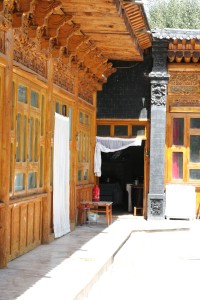Salar Living Conditions
This is day 12 of 32. Throughout April, we will be posting daily. We invite you to learn about Chinese Muslims and pray with us for God’s glory to be made known among them. If you would like to read other posts in this series, you can find them here.

Since most Salar live with their extended families, a home usually contains separate rooms for the parents, grandparents, and children, as well as a sitting room and a kitchen. Most of the bedrooms contain a kang, a stone bed that uses heated bricks placed underneath for warmth in the winter. In addition there are usually coffee tables and chairs for any guests who happen to drop by for a visit.
The ancient outward style of the Salar homes also does not reflect some of the modern conveniences found within. Almost every Salar home has a television set and DVD player. Many, even out in more remote villages, have a computer with internet access. Almost everyone, even the poor farmers, have a cell phone. The kitchen facilities are not much different than you would find decades ago, but more and more homes now have a refrigerator.
Did You Know? Located in the mountainous regions of north-central China, the 120,000 Salar people descended from Uzbekistan still retain some of their Central Asian appearance and proudly cling to their cultural roots. The majority of these Muslim people live in mud-baked homes and center their lives around agriculture, family and the local mosque, just as their Central Asian cousins still do.
Sanitation standards in most Salar areas are quite good, as is typical in most Islamic cultures. Salar homes are clean, food has its proper place, and the outhouse is distinctly separate from the rest of the home.
In addition, transportation is quite modern in and around Xunhua. Buses, cars, motorcycles and tractors are all an integral part of transit within the town. Getting to Xunhua is easier than it has ever been. With a new highway, the trip to Xining, the provincial capital and gateway to Xunhua, takes about four hours.
Prayer Requests:
- Family and community are very important to Salar people as shown through the layout of their homes and villages. Pray that Salar family members who believe in the Gospel will boldly share with their family and neighbors.
Pray that Salar families will welcome followers of Jesus into their homes and villages to proclaim the Gospel.
